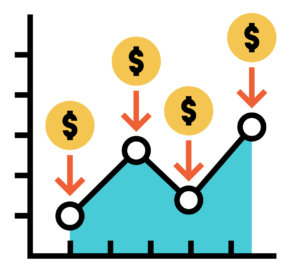
How does dollar cost averaging work?
To illustrate how dollar cost averaging works, let’s say that you want to save $3,000 each year. To reduce the risk of buying when the market is high, you decide to invest $250 in a mutual fund each month. As the following chart shows, this approach can help you take advantage of fluctuating markets because your $250 automatically buys fewer shares when prices are higher and more shares when prices are lower.
| Month | Investment amount | Market price per share | Number of shares purchased |
| January | $250 | $10 | 25 |
| February | $250 | $10 | 25 |
| March | $250 | $11 | 22.72 |
| April | $250 | $12 | 20.83 |
| May | $250 | $11 | 22.72 |
| June | $250 | $13 | 19.23 |
| July | $250 | $14 | 17.86 |
| August | $250 | $13 | 19.23 |
| September | $250 | $14 | 17.86 |
| October | $250 | $12 | 20.83 |
| November | $250 | $10 | 25 |
| December | $250 | $11 | 22.72 |
| This chart is a hypothetical example and does not reflect the return of any specific investment | |||
If you calculate the average market price per share over the 12-month period ($141 divided by 12), the result is $11.75. However, if you calculate your average cost per share over the same period ($3,000 divided by 259 shares), you’ll see that on average, you’ve paid only $11.58 per share.
Putting dollar cost averaging to work for you
You may not realize it, but if you’re investing a regular amount in a 401(k) or another employer-sponsored retirement plan via payroll deduction, you’re already using dollar cost averaging. In fact, you can use dollar cost averaging to invest for any long-term goal. It’s easy to get started, too. Many mutual funds, 529 plans and other investment accounts allow you to begin investing with a minimal amount as long as you have future contributions deducted regularly from your paycheck or bank account and invested automatically.
If you’re interested in dollar cost averaging, here are a few tips to help you put this strategy to work for you:
- Get started as soon as possible. Once you’ve decided that dollar cost averaging is right for you, start investing right away. The longer you have to ride out the ups and downs of the market, the more opportunity you have to build a sizeable investment account over time.
- Stick with it. Dollar cost averaging is a long-term investment strategy. Make sure that you have the financial resources and the discipline to invest continuously through all types of markets, regardless of price fluctuations.
- Take advantage of automatic deductions. Having your investment contributions deducted and invested automatically makes the process easy and convenient.
Broadridge Investor Communication Solutions, Inc. Copyright 2021
This content is provided by Windward Private Wealth Management Inc. (“Windward” or the “Firm”) for informational purposes only. Investing involves the risk of loss and investors should be prepared to bear potential losses. No portion of this blog is to be construed as a solicitation to buy or sell a security or the provision of personalized investment, tax or legal advice. Certain information contained in the individual blog posts will be derived from sources that Windward believes to be reliable; however, the Firm does not guarantee the accuracy or timeliness of such information and assumes no liability for any resulting damages.
Windward is an SEC registered investment adviser. The Firm may only provide services in those states in which it is notice filed or qualifies for a corresponding exemption from such requirements. For information about Windward’s registration status and business operations, please consult the Firm’s Form ADV disclosure documents, the most recent versions of which are available on the SEC’s Investment Adviser Public Disclosure website at www.adviserinfo.sec.gov.